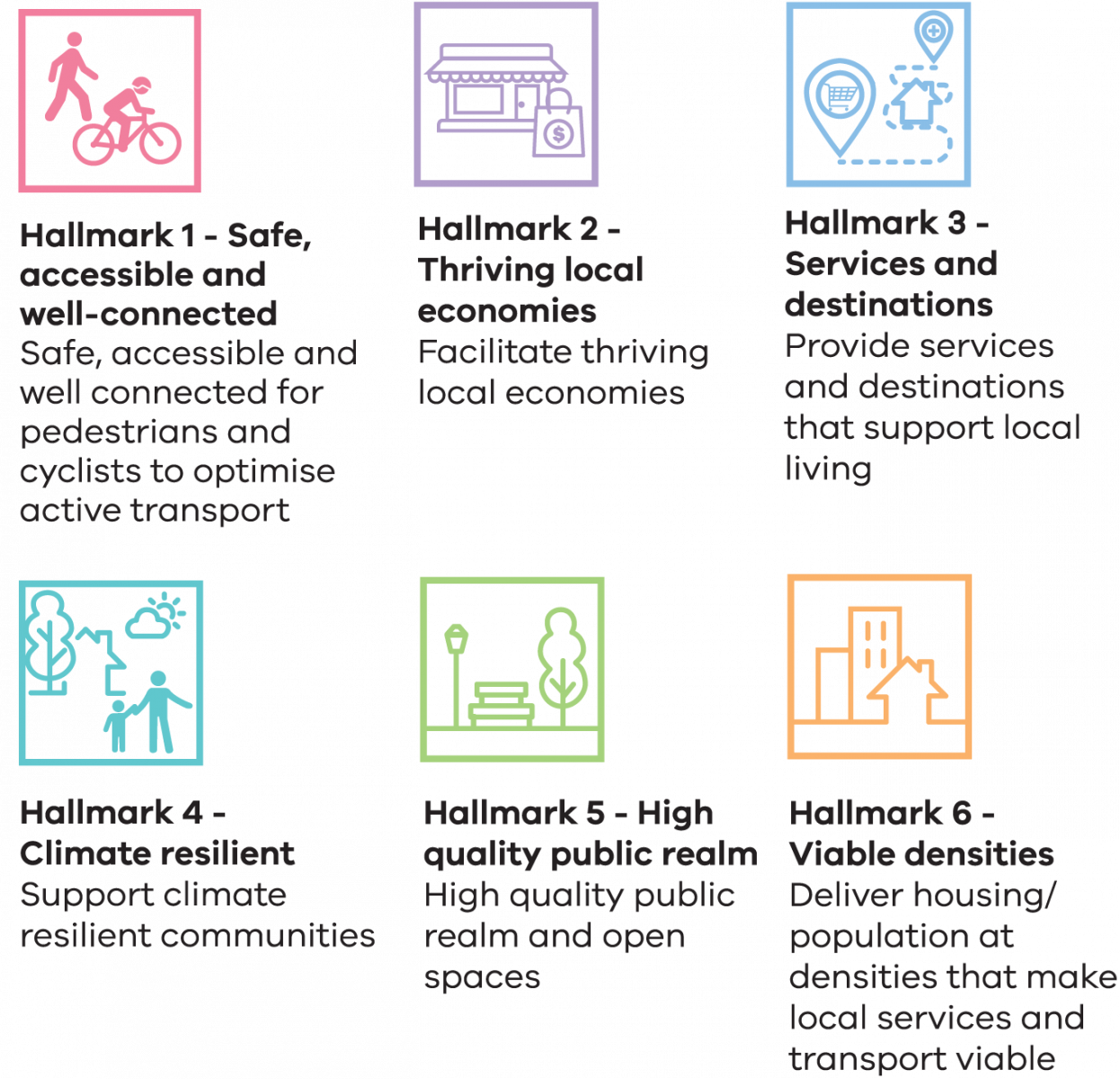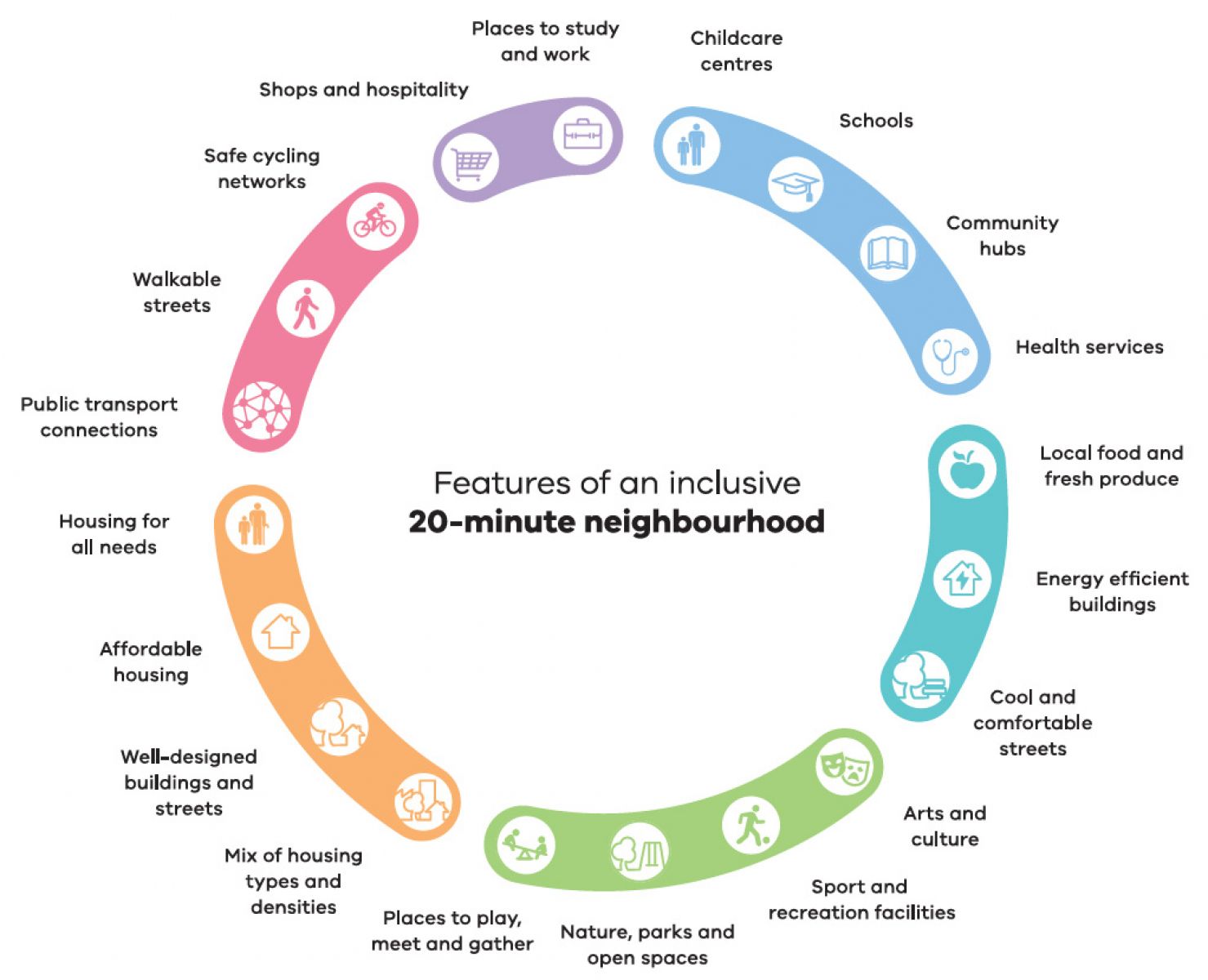What is a 20-minute neighbourhood?
The 20-minute neighbourhood is all about ‘living locally’ and enabling people to meet most of their daily needs within a 20-minute return walk from home. Plan Melbourne 2017–2050 is the Victorian Government’s long-term planning strategy, guiding the way the city will grow and change to 2050. Plan Melbourne is supported by the principle of 20-minute neighbourhoods.
Hallmarks of 20-minute neighbourhoods
To establish the features of a 20-minute neighbourhood as policy, the state government developed criteria to demonstrate ‘hallmarks’ of a 20-minute neighbourhood.
The ‘hallmarks’ are established in Plan Melbourne Direction 5 – Create a city of 20-minute neighbourhoods. They provide outcome measures that are an integrating framework to support delivery of more inclusive, vibrant and healthy neighbourhoods. They must:
Liveability, health and 20-minute neighbourhoods
Creating well-designed walkable neighbourhoods that are connected through a mix of land-uses, housing types and access to quality public transport, we can create more healthy, liveable communities. Liveable communities should have access to the following features:
Why focus on the neighbourhood scale?
Neighbourhoods are the places where we live, spend time with our family and friends, and connect with our community. These places are critical in supporting community health and wellbeing. Building pedestrian friendly neighbourhoods will help create a sustainable transport system by enabling short trips to be made walking.
“20-minute neighbourhoods can improve the quality of life for residents, who can live nearby public transport, shops, work and services” – Professor Carl Grodach, Monash University
If 50% of short private vehicle trips were instead made walking, it would save the Victorian economy approximately $165 million a year in congestion, health, infrastructure and environmental costs.
There is overwhelming evidence that active, walkable places produce a wealth of health, social, economic and environmental benefits.
How do we measure them?
Research shows that 20-minutes is the maximum time people are willing to walk to meet their daily needs locally.
These daily needs may include:
- local health facilities and services
- schools
- supermarkets.
This 20-minute journey represents an 800 metre walk from home to a destination and back again or a 10-minute walk to your destination and 10 minutes back home.
Different people will be able to walk a variety of distances and durations to meet their daily living needs. These measurements underpin our work to deliver inclusive, vibrant and healthy neighbourhoods. This reflects the intention of Outcome 5 of Plan Melbourne 2017-2050.
Note: The 800metre value is to be used as a guide only and offers a standard comparison measure that approximates the distance covered in a 20-minute return walk for the average person.
Delivery of 20-minute neighbourhoods
An update to Plan Melbourne was approved and released in January 2020 that seeks to embed an approach to 20-minute neighbourhoods in major infrastructure projects.
Work has already been undertaken to test delivery of 20-minute neighbourhoods. This highlighted the importance of developing partnerships with the community, bringing them along on the journey and empowering them to influence the direction of the work.
This work also found that a ‘place based’ approach to planning is effective. This involves bringing together stakeholders to think about the place or neighbourhood under a clear framework and coming to an agreed solution. This contrasts with individual and sometimes competing infrastructure and planning projects delivered in isolation.
It is important that neighbourhood and other centres within the catchment of new stations benefit from investment and growth, through placed based planning of local services, infrastructure and destinations.
This is particularly important for communities where there are (or there intends to be) higher concentrations of people, ensuring they are well connected to the stations and directly benefit from the significant investment being made.
These considerations are to be taken into account in the planning and delivery of the precincts around the new train stations.
Why are neighbourhood activity centres important?
Plan Melbourne 2017-2050 uses the land-use terms Metropolitan and Major Activity Centres for our larger commercial and retail centres. The development of these centres is guided by state government policy and significant resources are spent on their planning and development.
Neighbourhood activity centres (NACs) is the land-use term used to describe smaller, local centres. They are usually planned and managed by the local government.
20-minute neighbourhoods and NACs
In the past, both state and local governments have concentrated support on the larger centres, as they served the largest populations. They often have a concentration of services, uses and activities that attract people beyond the immediate walkable catchment. The smaller neighbourhood and local centres usually service local residents and provide a variety of daily living needs. These include;
- retail services and goods (newsagent, bakery, supermarket),
- local entertainment facilities (cafes and restaurants) and
- local health services and facilities.
For a healthy, walkable Neighbourhood Activity Centre to survive and thrive in order to enable people to ‘Live Locally’ they need enough people living within the walkable catchment to support them.
Network of 20-minute neighbourhoods
There are hundreds of neighbourhood activity centres scattered throughout Melbourne. While individually these places may only serve a local community’s needs, the network of these places across the city plays a significant role in creating a sustainable, equitable, and accessible city.
Revitalising and enabling neighbourhood activity centres to accommodate the necessary supporting populations is key to creating a city of 20-minute neighbourhoods. This is a long-term aspirational city shaping ambition which will evolve over time.

